Abstract
Gram-negative anaerobic bacilli isolated from specimens submitted to the routine diagnostic bacteriology laboratory and regarded as significant pathogens were identified by conventional bacteriological tests; 399 strains isolated from 356 specimens submitted from 332 patients were studied and most were readily identified by the results of a combined set of morphological, biochemical, tolerance and antibiotic disk resistance tests; B. fragilis has particular pathogenic potential and was the commonest species isolated, accounting for greater than 50% of strains. The next commonest was B. asaccharolyticus with 55 strains, and 16 other species or groups were represented by smaller numbers. Many (68%) were from infections related to the gastro-intestinal tract, but there were significant numbers from infections of the male and female genito-urinary tracts, the head, neck and central nervous system and from a variety of soft tissue infections. Most infections were mixed, and a pure culture of a Bacteroides sp. was obtained from only 26% of infections; two or more strains of Bacteroides were recovered from 55 infections. The specific identification of Bacteroides may help the bacteriologist to judge the significance of laboratory findings, influence the patient's management and prognosis and help determine the source of infection.
Full text
PDF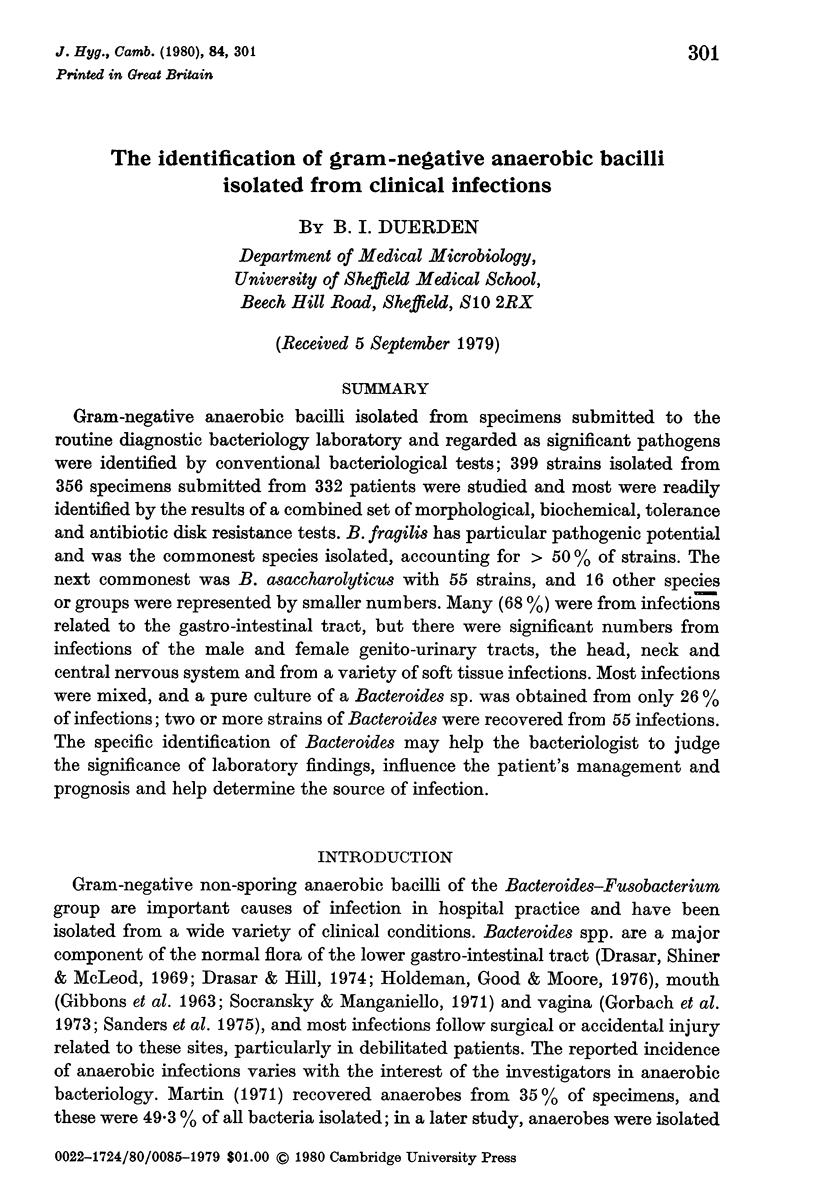
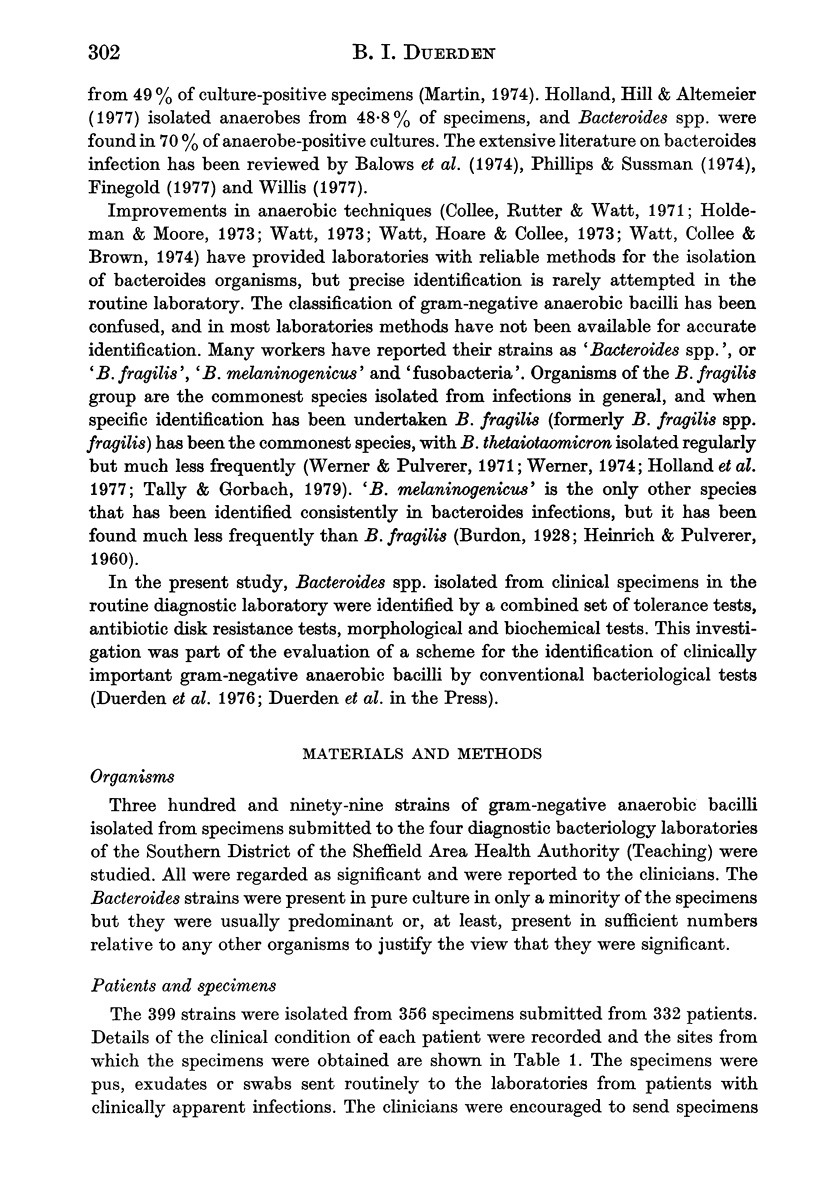
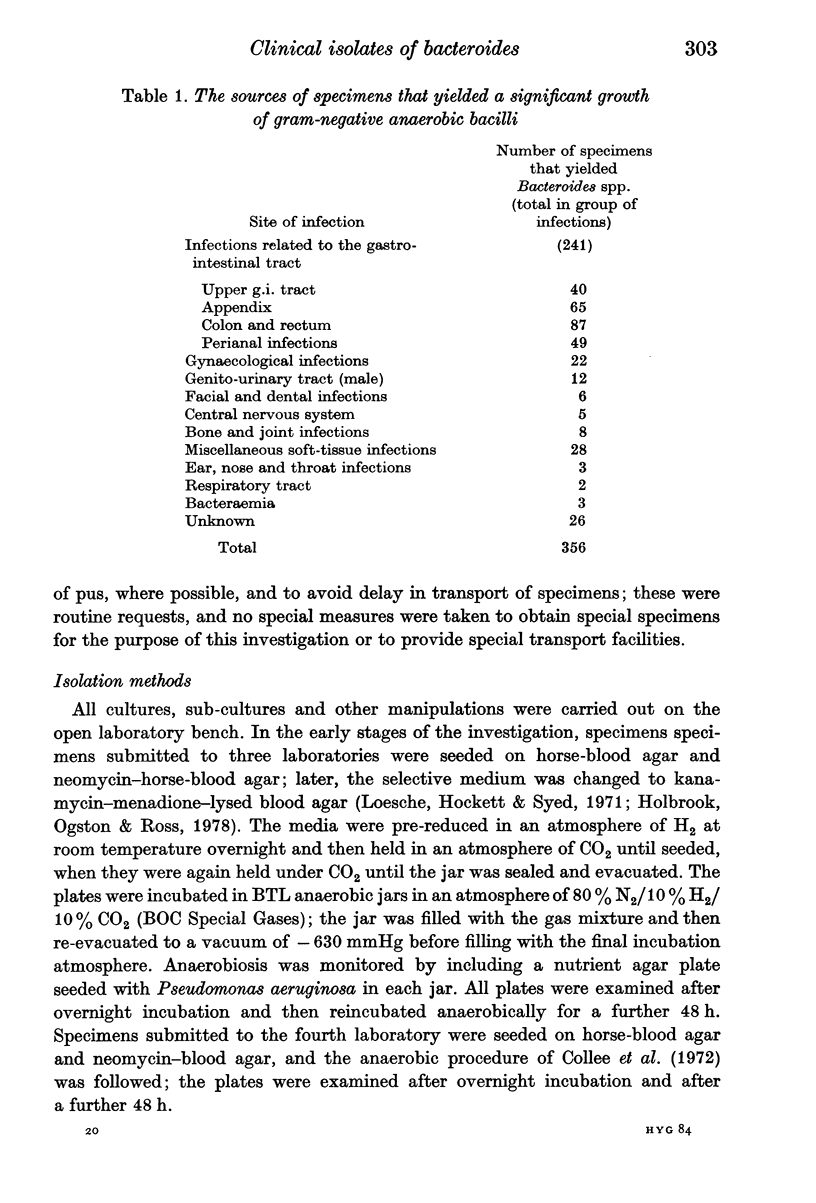
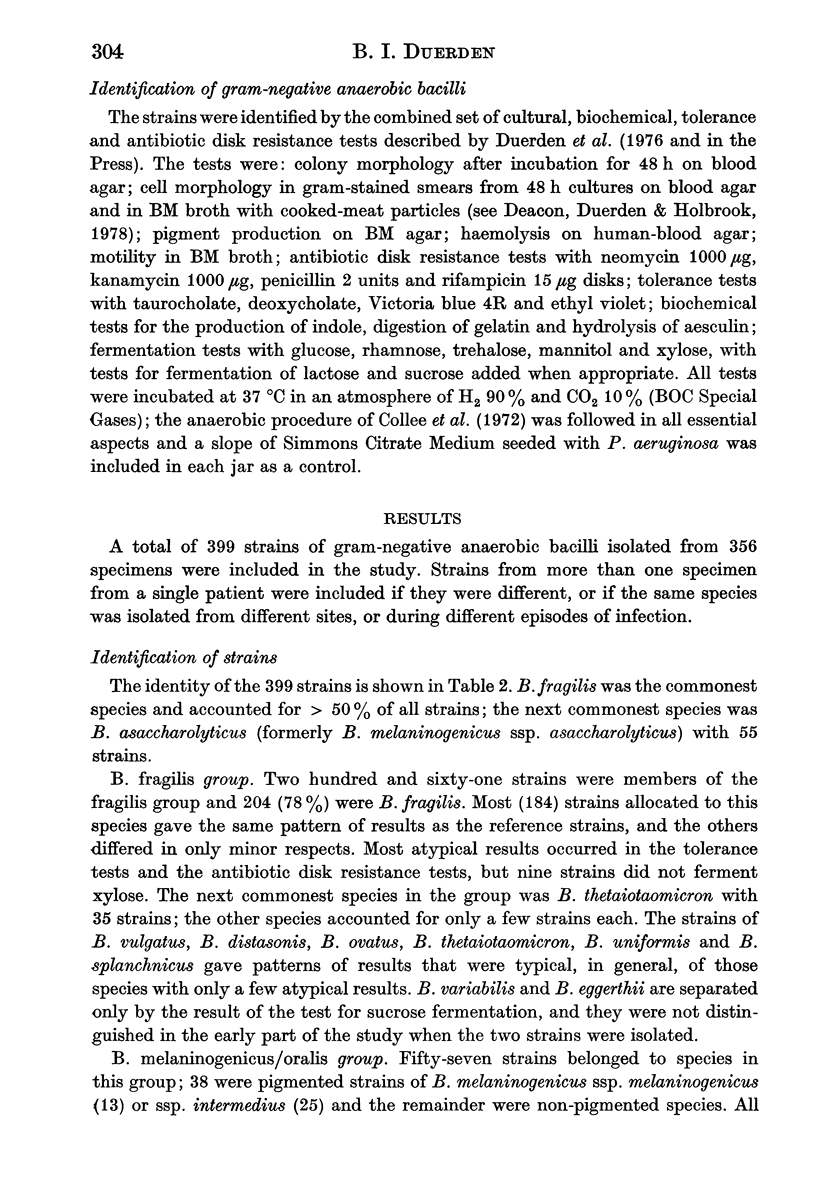
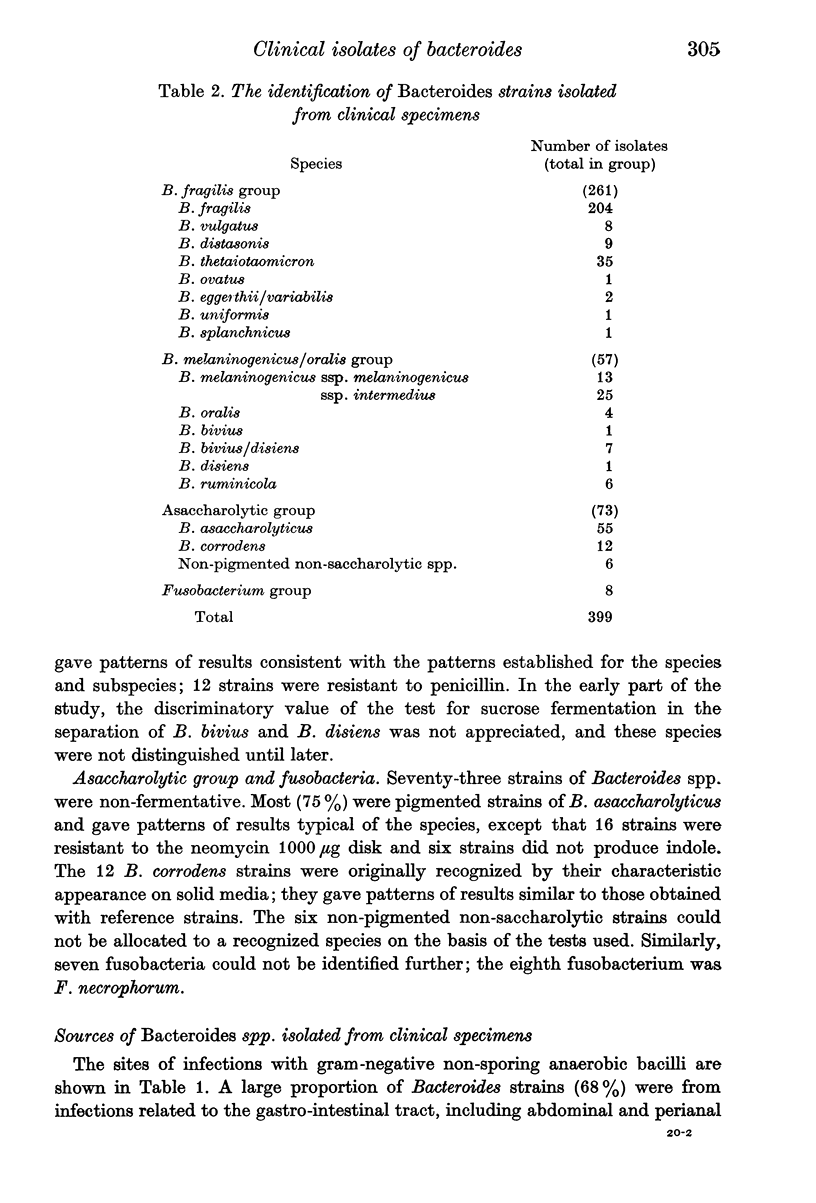

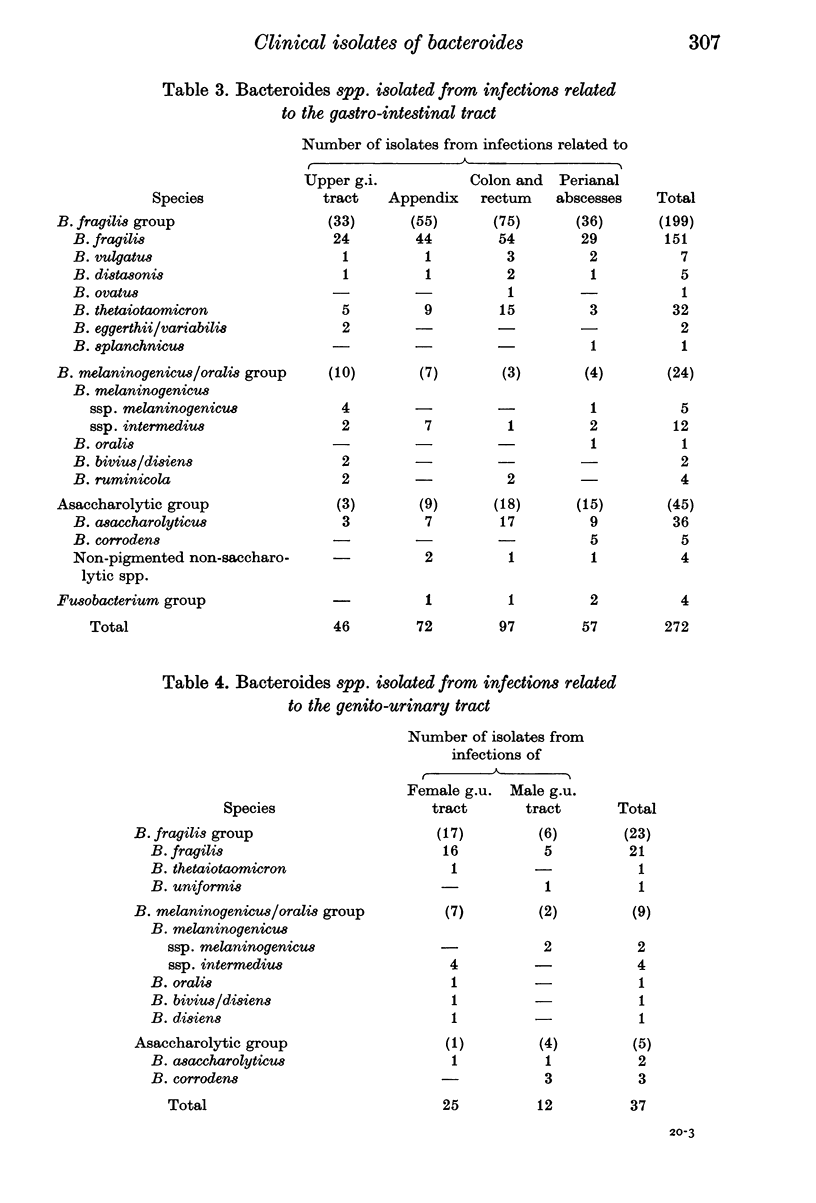
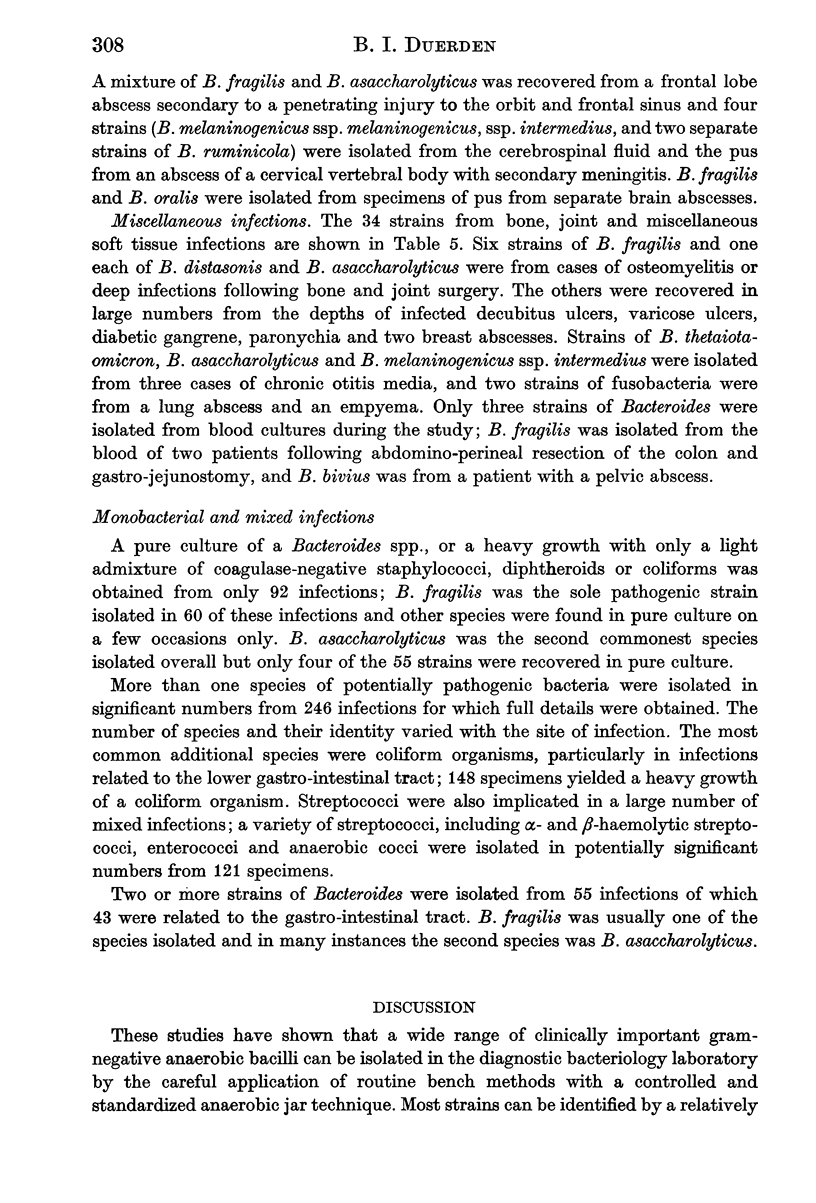
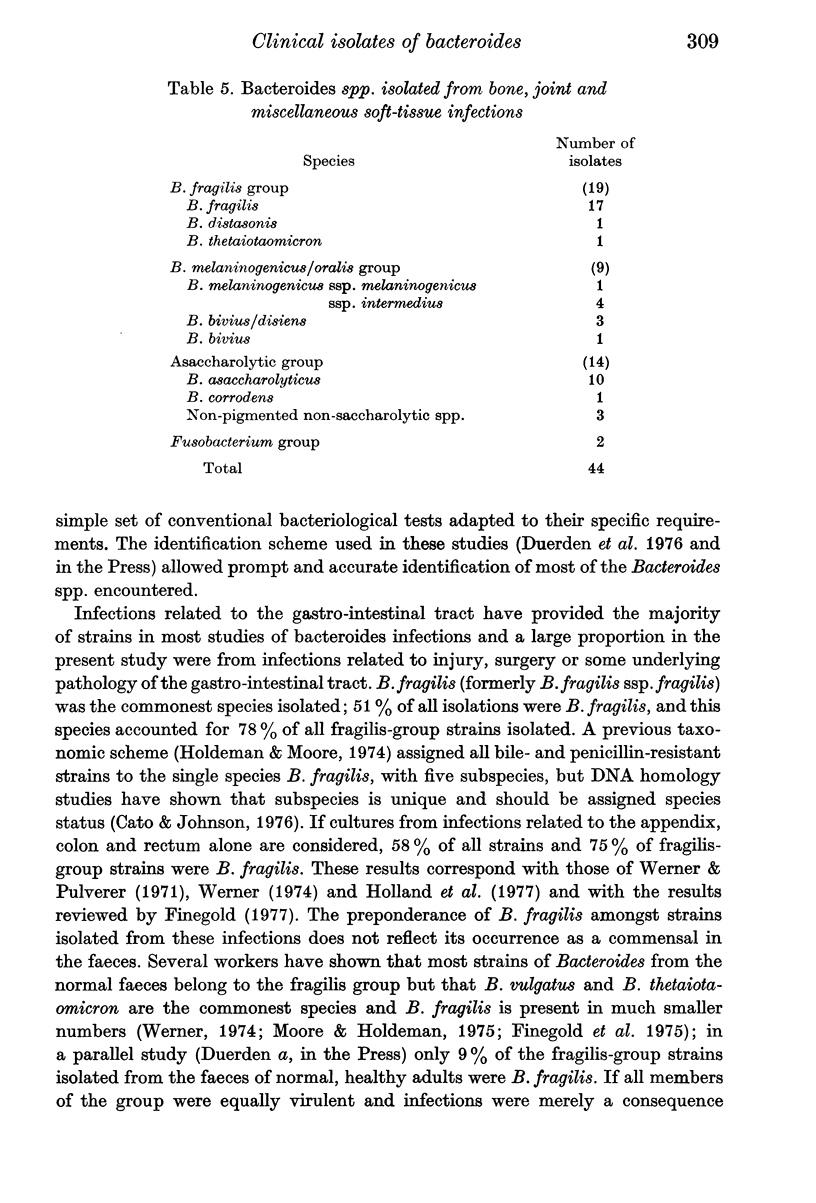
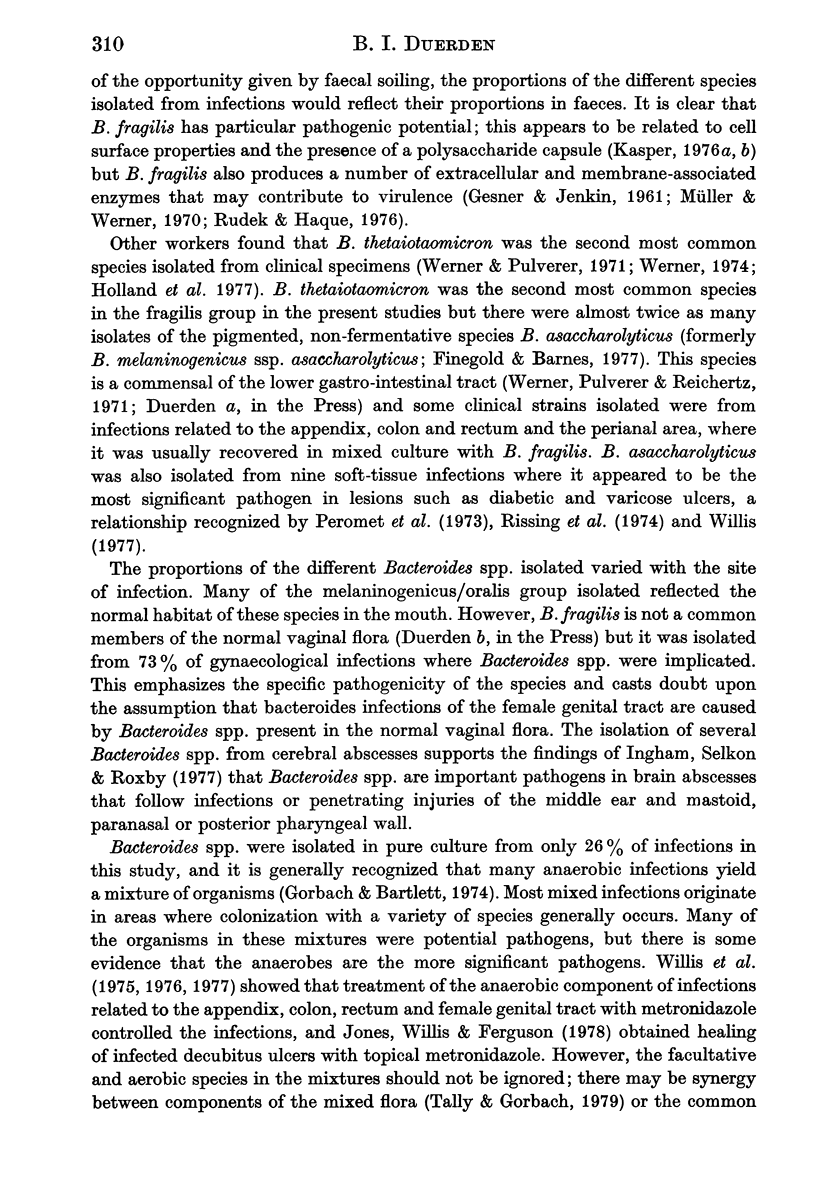
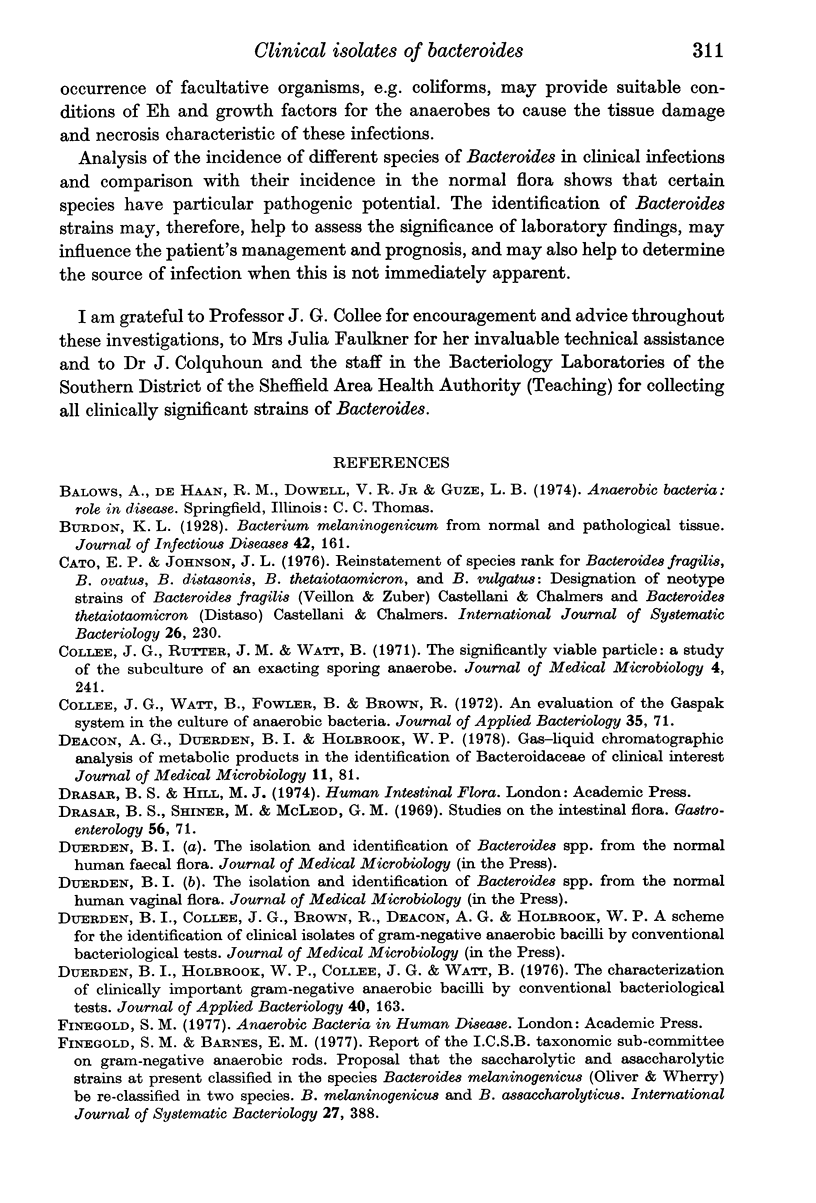
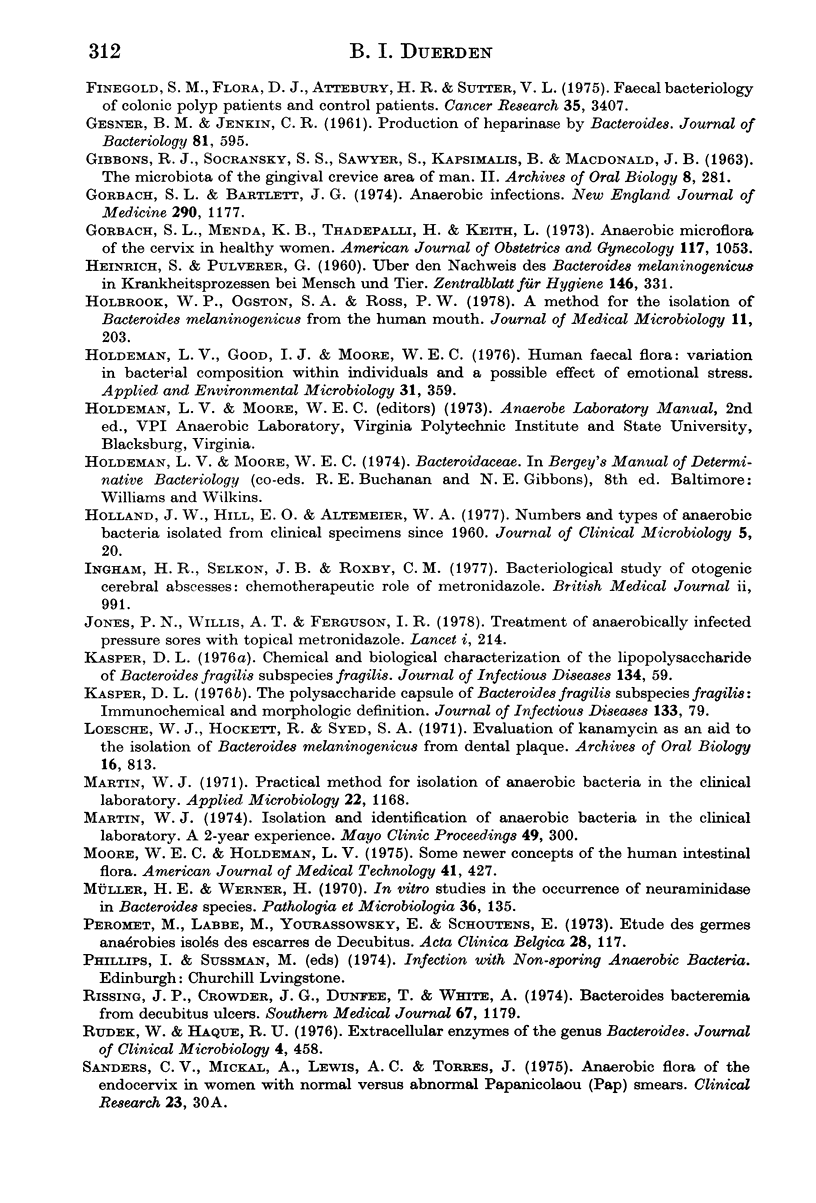
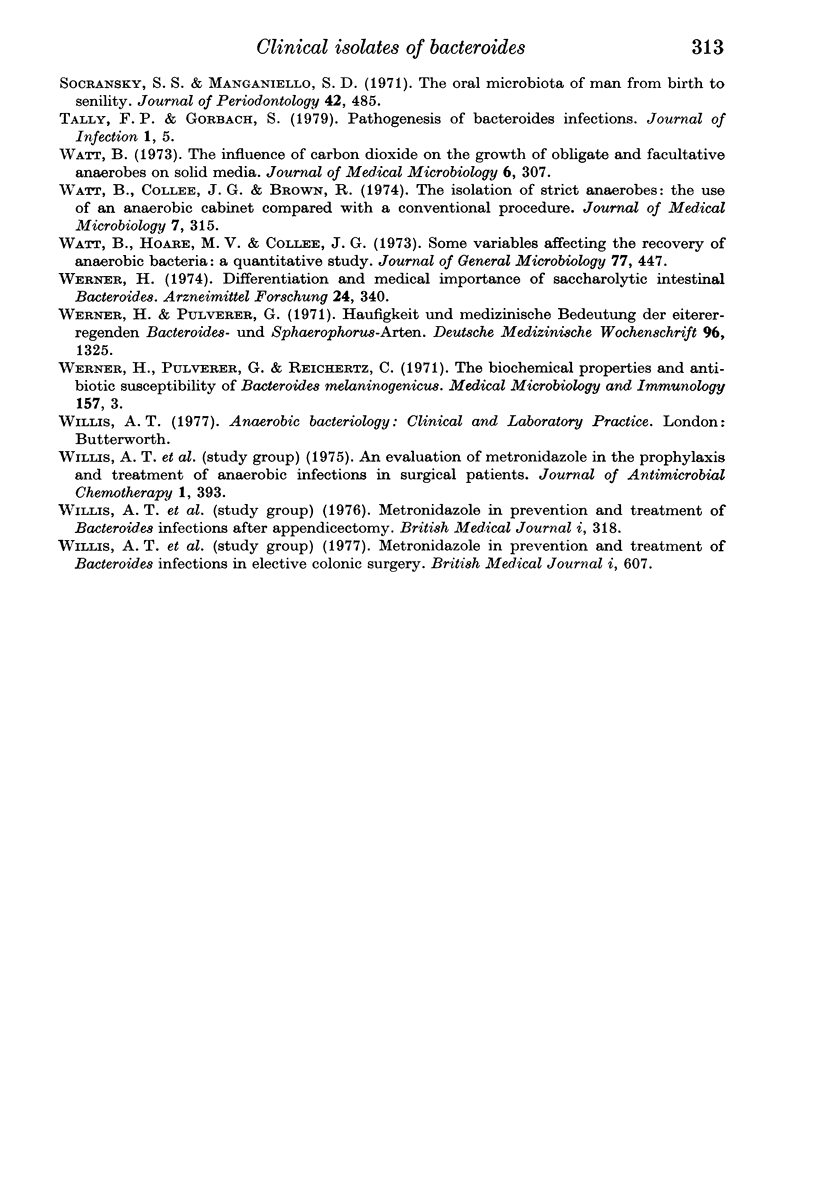
Selected References
These references are in PubMed. This may not be the complete list of references from this article.
- Collee J. G., Watt B., Fowler E. B., Brown R. An evaluation of the Gaspak system in the culture of anaerobic bacteria. J Appl Bacteriol. 1972 Mar;35(1):71–82. doi: 10.1111/j.1365-2672.1972.tb03675.x. [DOI] [PubMed] [Google Scholar]
- Drasar B. S., Shiner M., McLeod G. M. Studies on the intestinal flora. I. The bacterial flora of the gastrointestinal tract in healthy and achlorhydric persons. Gastroenterology. 1969 Jan;56(1):71–79. [PubMed] [Google Scholar]
- Duerden B. I., Holbrook W. P., Collee J. G., Watt B. The characterization of clinically important gram negative anaerobic bacilli by conventional bacteriological tests. J Appl Bacteriol. 1976 Apr;40(2):163–188. doi: 10.1111/j.1365-2672.1976.tb04164.x. [DOI] [PubMed] [Google Scholar]
- Finegold S. M., Flora D. J., Attebery H. R., Sutter V. L. Fecal bacteriology of colonic polyp patients and control patients. Cancer Res. 1975 Nov;35(11 Pt 2):3407–3417. [PubMed] [Google Scholar]
- GESNER B. M., JENKIN C. R. Production of heparinase by Bacteroides. J Bacteriol. 1961 Apr;81:595–604. doi: 10.1128/jb.81.4.595-604.1961. [DOI] [PMC free article] [PubMed] [Google Scholar]
- GIBBONS R. J., SOCRANSKY S. S., SAWYER S., KAPSIMALIS B., MACDONALD J. B. The microbiota of the gingival crevice area of man. II. The predominant cultivable organisms. Arch Oral Biol. 1963 May-Jun;8:281–289. doi: 10.1016/0003-9969(63)90020-7. [DOI] [PubMed] [Google Scholar]
- Gorbach S. L., Bartlett J. G. Anaerobic infections. 1. N Engl J Med. 1974 May 23;290(21):1177–1184. doi: 10.1056/NEJM197405232902106. [DOI] [PubMed] [Google Scholar]
- Gorbach S. L., Menda K. B., Thadepalli H., Keith L. Anaerobic microflora of the cervix in healthy women. Am J Obstet Gynecol. 1973 Dec 15;117(8):1053–1055. doi: 10.1016/0002-9378(73)90753-9. [DOI] [PubMed] [Google Scholar]
- Holbrook W. P., Ogston S. A., Ross P. W. A method for the isolation of Bacteroides melaninogenicus from the human mouth. J Med Microbiol. 1978 May;11(2):203–207. doi: 10.1099/00222615-11-2-203. [DOI] [PubMed] [Google Scholar]
- Holdeman L. V., Good I. J., Moore W. E. Human fecal flora: variation in bacterial composition within individuals and a possible effect of emotional stress. Appl Environ Microbiol. 1976 Mar;31(3):359–375. doi: 10.1128/aem.31.3.359-375.1976. [DOI] [PMC free article] [PubMed] [Google Scholar]
- Holland J. W., Hill E. O., Altemeier W. A. Numbers and types of anaerobic bacteria isolated from clinical specimens since 1960. J Clin Microbiol. 1977 Jan;5(1):20–25. doi: 10.1128/jcm.5.1.20-25.1977. [DOI] [PMC free article] [PubMed] [Google Scholar]
- Ingham H. R., Slekon J. B., Roxby C. M. Bacteriological study of otogenic cerebral abscesses: chemotherapeutic role of metronidazole. Br Med J. 1977 Oct 15;2(6093):991–993. doi: 10.1136/bmj.2.6093.991. [DOI] [PMC free article] [PubMed] [Google Scholar]
- Jones P. H., Willis A. T., Ferguson I. R. Treatment of anaerobically infected pressure sores with topical metronidazole. Lancet. 1978 Jan 28;1(8057):213–214. [PubMed] [Google Scholar]
- Kasper D. L. Chemical and biological characterization of the lipopolysaccharide of Bacteroides fragilis subspecies fragilis. J Infect Dis. 1976 Jul;134(1):59–66. doi: 10.1093/infdis/134.1.59. [DOI] [PubMed] [Google Scholar]
- Loesche W. J., Hockett R., Syed S. A. Evaluation of Kanamycin as an aid in the isolation of Bacteroides melaninogenicus from dental plaque. Arch Oral Biol. 1971 Jul;16(7):813–815. doi: 10.1016/0003-9969(71)90125-7. [DOI] [PubMed] [Google Scholar]
- Martin W. J. Isolation and indentification of anaerobic bacteria in the clinical laboratory. A 2-year experience. Mayo Clin Proc. 1974 May;49(5):300–308. [PubMed] [Google Scholar]
- Martin W. J. Practical method for isolation of anerobic bacteria in the clinical laboratory. Appl Microbiol. 1971 Dec;22(6):1168–1171. doi: 10.1128/am.22.6.1168-1171.1971. [DOI] [PMC free article] [PubMed] [Google Scholar]
- Moore W. E., Holdeman L. V. Some newer concepts of the human intestinal flora. Am J Med Technol. 1975 Nov;41(11):427–430. [PubMed] [Google Scholar]
- Müller H. E., Werner H. In vitro-Untersuchungen über das Vorommen von Neuraminidase bei Bacteroides-Arten. Pathol Microbiol (Basel) 1970;36(3):135–152. [PubMed] [Google Scholar]
- Peromet M., Labbe M., Yourassowsky E., Schoutens E. Etude des germes anaérobies isolés des escarres de decubitus. Acta Clin Belg. 1973;28(2):117–121. doi: 10.1080/17843286.1973.11716862. [DOI] [PubMed] [Google Scholar]
- Rissing J. P., Crowder J. G., Dunfee T., White A. Bacteroides bacteremia from decubitus ulcers. South Med J. 1974 Oct;67(10):1179–1182. doi: 10.1097/00007611-197410000-00011. [DOI] [PubMed] [Google Scholar]
- Rudek W., Haque R. U. Extracellular enzymes of the genus Bacteroides. J Clin Microbiol. 1976 Nov;4(5):458–460. doi: 10.1128/jcm.4.5.458-460.1976. [DOI] [PMC free article] [PubMed] [Google Scholar]
- Socransky S. S., Manganiello S. D. The oral microbiota of man from birth to senility. J Periodontol. 1971 Aug;42(8):485–496. doi: 10.1902/jop.1971.42.8.485. [DOI] [PubMed] [Google Scholar]
- Watt B., Collee J. G., Brown R. The isolation of strict anaerobes: the use of an anaerobic cabinet compared with a conventional procedure. J Med Microbiol. 1974 Aug;7(3):315–324. doi: 10.1099/00222615-7-3-315. [DOI] [PubMed] [Google Scholar]
- Watt B., Hoare M. V., Collee J. G. Some variables affecting the recovery of anaerobic bacteria: a quantitative study. J Gen Microbiol. 1973 Aug;77(2):447–454. doi: 10.1099/00221287-77-2-447. [DOI] [PubMed] [Google Scholar]
- Watt B. The influence of carbon dioxide on the growth of obligate and facultative anaerobes on solid media. J Med Microbiol. 1973 Aug;6(3):307–314. doi: 10.1099/00222615-6-3-307. [DOI] [PubMed] [Google Scholar]
- Werner H. Differentiation and medical importance of saccharolytic intestinal Bacteroides. Arzneimittelforschung. 1974 Mar;24(3):340–343. [PubMed] [Google Scholar]
- Werner H., Pulverer G. Häufigkeit und medizinische Bedeutung der eitererregenden Bacteroides- und Sphaerophorus-Arten. Dtsch Med Wochenschr. 1971 Aug;96(33):1325–1329. doi: 10.1055/s-0028-1110134. [DOI] [PubMed] [Google Scholar]
- Werner H., Pulverer G., Reichertz C. The biochemical properties and antibiotic susceptibility of Bacteroides melaninogenicus. Med Microbiol Immunol. 1971;157(1):3–9. doi: 10.1007/BF02121285. [DOI] [PubMed] [Google Scholar]
- Willis A. T., Ferguson I. R., Jones P. H., Phillips K. D., Tearle P. V., Berry R. B., Fiddian R. V., Graham D. F., Harland D. H., Innes D. B. Metronidazole in prevention and treatment of bacteroides infections after appendicectomy. Br Med J. 1976 Feb 7;1(6005):318–321. doi: 10.1136/bmj.1.6005.318. [DOI] [PMC free article] [PubMed] [Google Scholar]
- Willis A. T., Ferguson I. R., Jones P. H., Phillips K. D., Tearle P. V., Fiddian R. V., Graham D. F., Harland D. H., Hughes D. F., Knight D. Metronidazole in prevention and treatment of bacteroides infections in elective colonic surgery. Br Med J. 1977 Mar 5;1(6061):607–610. doi: 10.1136/bmj.1.6061.607. [DOI] [PMC free article] [PubMed] [Google Scholar]


